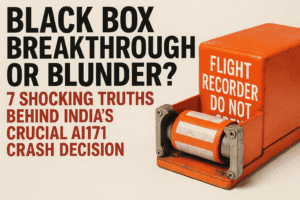The recovery of both flight recorders from the wreckage of Air India flight AI171 marks a critical step in the investigation, but it presents India’s Aircraft Accident Investigation Bureau (AAIB) with a significant, high-stakes decision: Where should the damaged black boxes be decoded?
Contrary to speculation, the Ministry of Civil Aviation (MoCA) confirmed on June 20th that no final decision has been made. The AAIB will determine the location for data extraction and analysis only after a thorough assessment of “all technical, safety, and security considerations.”
The Core Dilemma:
- India’s New Lab: The AAIB recently inaugurated a state-of-the-art black box laboratory in Delhi (April 2025), built with Hindustan Aeronautics Ltd (HAL) support. This facility represents a major leap forward, designed to repair damaged units, retrieve data, and conduct high-accuracy analyses domestically – a capability India previously lacked in critical aspects.
- US Expertise: The alternative is sending the recorders to the renowned National Transportation Safety Board (NTSB) Vehicle Recorder Laboratory in the United States. The NTSB is already assisting the AAIB due to Boeing’s involvement as the aircraft manufacturer (the crashed plane was a Boeing 787). Their lab possesses extensive experience handling severely damaged units and complex data recovery.
Why the Decision is Complex:
- Condition is Paramount: The extent of damage to the two recovered Enhanced Airborne Flight Recorders (EAFRs) – each combining Cockpit Voice Recorder (CVR) and Digital Flight Data Recorder (DFDR) functions – is unknown. MoCA has not commented on their state. The primary factor will be the AAIB’s confidence in their own lab’s ability to successfully extract all critical data from these specific units. Can their new facility handle the level of damage sustained?
- Beyond Basic Retrieval: It’s not just about getting some data; it’s about ensuring complete and reliable retrieval. The investigation may require extremely sophisticated analysis beyond standard readouts. Does the AAIB lab possess the depth of analytical capability needed for this specific, complex accident?
- Security & Oversight: If sent abroad, sources indicate an AAIB team would accompany the recorders to ensure their chain of custody, physical security, and the integrity of the data extraction process. This adds logistical complexity.
- Technical Nuance: While the new Delhi lab is “world-class,” industry sources acknowledge that a handful of specialized international labs, like the NTSB’s, may possess even more advanced capabilities for handling extreme cases or performing highly specialized analyses. The question is whether this case requires that level.
The Stakes:
This decision transcends logistics. Sending the black boxes abroad, while sometimes necessary, has historically highlighted gaps in India’s investigative infrastructure. Successfully analyzing them in Delhi would be a powerful demonstration of India’s growing technical autonomy and sophistication in aviation safety investigation. Conversely, choosing the NTSB would be a pragmatic acknowledgment that this specific accident demands the most experienced hands available globally.
The Path Forward:
The AAIB investigation is progressing methodically. Key site documentation and evidence collection at the Ahmedabad crash site are complete. The focus now shifts intensely to the black boxes. The CVR holds the cockpit’s acoustic environment – pilot conversations, alarms, and control movements. The DFDR contains thousands of data points on the aircraft’s flight path, systems performance, and controls.
MoCA has rightly urged against speculation, emphasizing the need for professionalism. The AAIB’s choice won’t be about national pride, but about cold, hard technical assessment: Where is the absolute best place, considering the condition of these specific recorders and the needs of this specific investigation, to guarantee the complete and accurate data needed to understand why AI171 crashed?
The world of aviation safety watches closely. The integrity of the data extracted from these damaged “black boxes” is foundational to uncovering the truth and preventing future tragedies. The AAIB’s deliberation carries immense weight.

You must be logged in to post a comment.